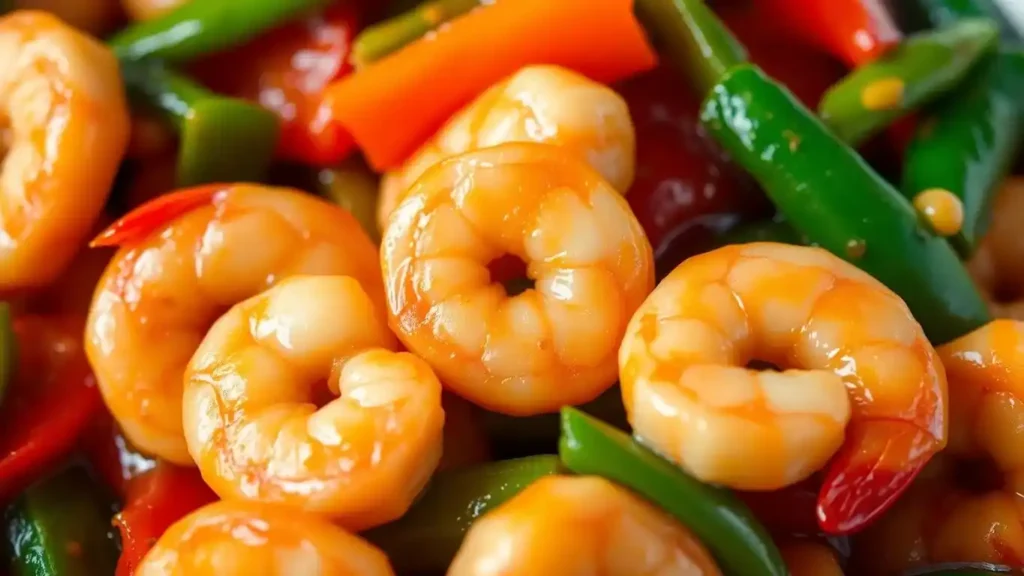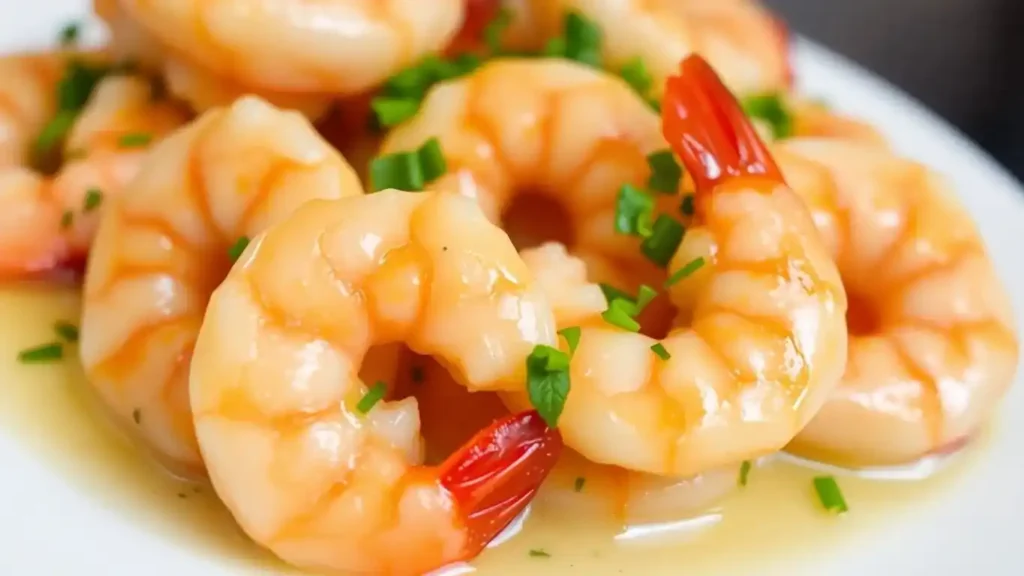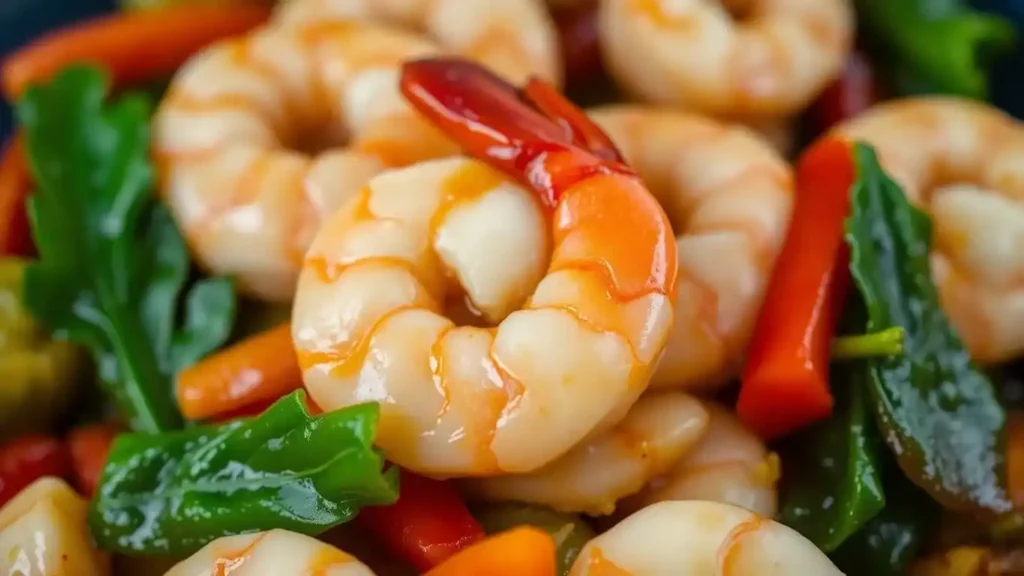Ever wondered why the shrimp at your favorite Chinese restaurant is always so incredibly tender and juicy? It’s not magic, but rather a few clever techniques that transform these little sea creatures into something special. From velveting to brining, and even using alkaline water, these methods ensure that every bite is a delight. If you’ve ever tried to replicate that restaurant-quality shrimp at home and ended up with rubbery results, you’re not alone. Let’s explore how Chinese chefs achieve this culinary magic and how you can do it too.
Key Takeaways
- Velveting shrimp involves marinating them in cornstarch and egg whites for a silky texture.
- Brining shrimp in a saltwater solution helps to enhance their natural flavor and tenderness.
- Alkaline water can be used to improve the texture of shrimp, making it firmer and crunchier.
- Marinating shrimp with the right ingredients is crucial for achieving the desired tenderness.
- Proper cooking techniques, like stir-frying and steaming, prevent shrimp from becoming overcooked.
Table of contents
Understanding the Art of Velveting Tender Shrimp
What is Velveting?
Velveting is a technique that gives shrimp that silky, tender texture you find in many Chinese dishes. The process involves coating the shrimp in a mixture of cornstarch, egg white. This “bath” creates a protective layer that locks in moisture, preventing the shrimp from becoming rubbery during cooking.
The Science Behind Velveting
At its core, velveting is all about moisture retention. The cornstarch mixture forms a barrier around the shrimp, sealing in juices. This helps the shrimp stay succulent and prevents the dreaded chewy texture. When cooked, the shrimp has a crisp texture on the outside while remaining tender inside.
Common Ingredients Used in Velveting
To achieve perfectly velveted shrimp, you’ll need:
- Cornstarch: Essential for creating that silky coating.
- Egg White: Helps bind the cornstarch to the shrimp.
- Salt: Enhances the overall taste.
- Pepper Flakes: Optional, but adds a hint of heat.
Velveting might seem like a fancy term, but it’s really just about giving your shrimp a little TLC. Once you try it, you’ll never go back to plain cooking methods. The butterfly method can also be used to ensure even coating. Remember, the key is not to rush—let the shrimp soak in the marinade for at least 20-30 minutes. This way, you avoid rubbery shrimp and get that melt-in-your-mouth experience.
The Role of Brining in Tenderizing Shrimp
How Brining Works
Brining shrimp is a simple yet effective method that involves soaking the shrimp in a solution of water and salt. This process helps to enhance the shrimp’s natural flavors while ensuring they remain juicy and tender during cooking. The salt in the brine alters the muscle fibers, allowing them to retain more moisture. This prevents the shrimp from becoming dry and rubbery, a common issue when cooking seafood.
Benefits of Brining Shrimp
Brining offers several advantages:
- Flavor Enhancement: The salt penetrates the shrimp, seasoning them from the inside out.
- Improved Texture: The brine helps maintain a plump and juicy texture.
- Increased Tenderness: The shrimp remain soft and succulent, even after cooking.
Step-by-Step Brining Process to tender shrimp
To brine shrimp effectively, follow these steps:
- Prepare the Brine: Mix 1/4 cup of salt with 4 cups of cold water in a large bowl.
- Soak the Shrimp: Submerge the shrimp in the brine for 15 to 30 minutes.
- Rinse and Dry: Rinse the shrimp under cold water and pat them dry with paper towels.
- Cook: Proceed with your favorite shrimp recipe, like a broccoli saute for a delightful meal.
Brining is the secret to achieving perfectly tender shrimp, making every bite a delightful experience. Whether you’re preparing a stir-fry or a crunchy broccoli dish, this technique ensures your shrimp are always the star of the show.
Exploring the Use of Alkaline Water
Why Alkaline Water?
Alkaline water, with a pH level around 9, is often used in Chinese cooking to achieve that signature crunchy texture in shrimp. This method is popular because it mimics the natural environment of sea water, which has a similar pH level. The alkaline environment helps to firm up the shrimp, giving it that desired “bounce” when you bite into it. This technique is a well-kept secret among many Chinese chefs, ensuring their shrimp dishes stand out.
Effects on Shrimp Texture
The use of alkaline water in shrimp preparation significantly impacts the texture. By altering the pH level, the water helps to tighten the proteins in the shrimp, which results in a firmer and more elastic bite. This method is particularly effective when combined with a light massage of the shrimp during marination. The end result is shrimp that not only tastes fresh but also holds its shape and texture during cooking.
Alternatives to Alkaline Water
If alkaline water isn’t available, there are alternatives that can achieve similar results. One common method is using a mixture of baking soda and cold water. Baking soda, when dissolved in water, increases the pH level, creating an alkaline solution. Here’s a simple way to prepare this at home:
- Prepare a Bowl of Water: Fill a bowl with cold water and add a small amount of baking soda.
- Mix Thoroughly: Stir the solution until the baking soda is completely dissolved.
- Soak the Shrimp: Place the shrimp in the solution and let them soak for about 30 minutes.
After soaking, rinse the shrimp under cold running water to remove any excess baking soda. This method not only enhances the texture but also ensures the shrimp is clean and ready for cooking.
Using these techniques can transform your home-cooked shrimp dishes into restaurant-quality meals. The next time you’re preparing shrimp, consider experimenting with alkaline water or its alternatives to see the difference it makes in texture and taste.
For a recipe that emphasizes experimentation with shrimp and other ingredients, check out this delightful Chinese shrimp and green beans dish.
Mastering the Marination Process to tender shrimp
Essential Marination Ingredients
Marinating shrimp is all about creating a balanced sauce that enhances the natural flavors. The classic preparation often includes cornstarch, egg whites. These ingredients help in the absorption of sauces, ensuring the shrimp remains juicy and tender. Consider adding a dash of sesame oil for a nutty aroma, or some baking soda for extra tenderness.
Techniques for Effective Marination
To achieve the best results, follow these steps:
- Basic method: Mix your marinade ingredients thoroughly before adding the shrimp. This ensures each piece is evenly coated.
- Common method: Let the shrimp soak in the marinade for at least 20-30 minutes in the fridge. This time allows the flavors to penetrate deep into the shrimp.
- Alternative method: If you’re short on time, a quick 10-minute marination can also work, but the longer, the better for flavor absorption.
Timing and Temperature Considerations
Timing is everything in marination. For a beef stir fry marinade, longer marination can enhance flavor, but with shrimp, you want to avoid overdoing it. The combination of vegetable oils and other ingredients should not overpower the shrimp’s natural taste. Always keep your marinated shrimp chilled to prevent any spoilage.
Marination isn’t just about flavor—it’s about texture too. The right ingredients and techniques ensure your shrimp are not just tasty but perfectly tender. Remember, over-marinating can lead to mushy shrimp, so keep an eye on the clock.
For those interested in a lemony shrimp and bean stew, marinated shrimp can add a delightful depth of flavor, complementing the tangy lemon broth beautifully.
Cooking Techniques for Perfectly Tender Shrimp

Stir-Frying Tips
Stir-frying is a quick and effective way to prepare shrimp, keeping them juicy and tender. The key is high heat and speed. Start by heating your wok or pan until it’s searing hot before adding any oil. This ensures your shrimp cook quickly, sealing in their juices. For a classic Chinese shrimp dish, consider adding vegetables like broccoli into florets or even beef for stir-fry to complement the shrimp’s flavor. Avoid overcrowding the pan, as this can lead to steaming rather than frying.
Steaming for Tenderness
Steaming is another gentle cooking method that preserves the natural sweetness of shrimp. Place your raw shrimp on a steamer basket over boiling water, cover, and let them steam for just a few minutes until they turn pink and opaque. This method is perfect for dishes like coconut shrimp or shrimp with eggs, where you want to highlight the shrimp’s natural flavor without overpowering it.
Avoiding Overcooking
Overcooking is the nemesis of tender shrimp. Whether you’re dealing with raw shrimp or frozen shrimp, the trick is to cook them just until they turn opaque. Medium shrimp usually take about 2-3 minutes per side. If you’re using cooked shrimp in a recipe for shrimp, simply add them at the end to warm through without further cooking. This way, you ensure succulent shrimp every time.
Cooking shrimp is all about timing. Get it right, and you’ll have juicy shrimp that melt in your mouth. Miss the mark, and you’ll end up with rubbery seafood that’s far from appetizing.
For those who love a crispy shrimp texture, consider flash-frying. This involves frying the shrimp at high temperatures for a short period, creating a crispy outer layer while keeping the inside tender. Serve with plain rice to balance the flavors, or use them in a classic shrimp cocktail for a refreshing appetizer.
Secrets from Chinese Chefs

Traditional Methods Revealed
Chinese chefs have mastered the art of crafting tender shrimp through techniques passed down through generations. One such technique involves rinsing shrimp under cold running water to firm up the flesh, a method shared by a renowned Chinese chef in Hong Kong. This practice enhances the shrimp’s texture, making it a favorite in many Chinese dishes. The secret lies in the meticulous preparation and attention to detail, ensuring each shrimp is perfectly tender.
Modern Adaptations
While traditional methods hold their ground, modern adaptations have emerged in Chinese cooking. Chefs now often use a bit of oyster sauce or a chili paste-sherry mixture to marinate shrimp, adding depth to the flavor profile. Alkaline water, with a pH of 9, is another modern twist that helps achieve that sought-after texture. These innovations, combined with classic techniques, create a harmonious blend of old and new in Chinese seafood recipes.
Common Mistakes to Avoid
Avoiding overcooking is crucial in preparing shrimp. Overcooked shrimp can become rubbery, losing their delicate texture. Additionally, not properly marinating or using the wrong ingredients, like too much black bean chili paste or chili flakes, can overpower the dish. It’s also essential to pair the shrimp with the right accompaniments, such as broccoli florets or white rice, to balance the flavors. Lastly, always ensure your shrimp are fresh, as this significantly impacts the final dish quality.
The Importance of Fresh Ingredients

Selecting the Best Shrimp
Choosing the right shrimp is the first step to achieving that restaurant-quality tenderness. Always opt for frozen shrimp over those displayed at the seafood counter. It might sound odd, but frozen shrimp are often fresher since they’re flash-frozen right after being caught. This process locks in their natural flavor and texture. When you’re at the store, look for packages labeled with just “shrimp” as the ingredient, avoiding additives that can affect taste and texture.
Handling and Storage Tips for tender Shrimp
Once you’ve got your shrimp, proper handling is key. Keep them frozen until you’re ready to use them. If you need to thaw them, do it safely by placing them in the refrigerator overnight. Never leave shrimp out at room temperature to thaw, as this can lead to bacterial growth and spoilage. After thawing, rinse them gently under cold water to remove any ice crystals or residues.
Impact on Final Dish Quality
The freshness of your shrimp can make or break your dish. Fresh, well-handled shrimp have a sweet, mild flavor and a firm texture that stands up to cooking. They absorb marinades and spices more effectively, ensuring that each bite is packed with flavor. On the flip side, shrimp that have been poorly handled or are not fresh can taste rubbery and bland, ruining even the best recipes.
Fresh ingredients are the cornerstone of any great dish, and shrimp is no exception. The quality of your shrimp directly influences the taste and texture of the final dish, transforming a simple meal into a culinary delight.
Wrapping It Up: The Secret to Tender Shrimp
So there you have it, the mystery behind those perfectly tender shrimp at your favorite Chinese restaurant. It’s all about the technique, whether it’s the brining, velveting, or that special alkaline water trick. These methods might seem a bit much for a home cook, but give them a shot. You might just surprise yourself with how close you can get to that restaurant quality. Remember, it’s not just about the ingredients, but how you treat them. So next time you’re cooking shrimp, try out these tips and see the difference. Who knows, you might just become the go-to shrimp chef in your circle!
Frequently Asked Questions About Tender Shrimp
What is the secret to tender shrimp in Chinese dishes?
Chinese restaurants often use a technique called velveting, which involves coating the shrimp in a mixture of cornstarch and egg whites before cooking. This helps keep the shrimp tender and moist.
How does brining help in tenderizing shrimp?
Brining shrimp in a saltwater solution helps remove any unwanted flavors and makes the shrimp more succulent by allowing them to retain moisture during cooking.
Why is alkaline water used in preparing shrimp?
Alkaline water helps to firm up the shrimp, making them crunchy and giving them a pleasant texture. It changes the pH level, which affects the shrimp’s texture.
What ingredients are essential for marinating shrimp?
Common ingredients for marinating shrimp include egg whites, cornstarch, and baking soda. These help to tenderize the shrimp and improve their texture.
What are some cooking techniques for perfectly tender shrimp?
Stir-frying and steaming are popular methods. The key is to cook shrimp quickly over high heat to prevent them from becoming rubbery.
How do Chinese chefs ensure the shrimp is fresh?
Chefs select high-quality shrimp and store them properly. They often use fresh shrimp and handle them carefully to maintain their natural flavor and texture.
